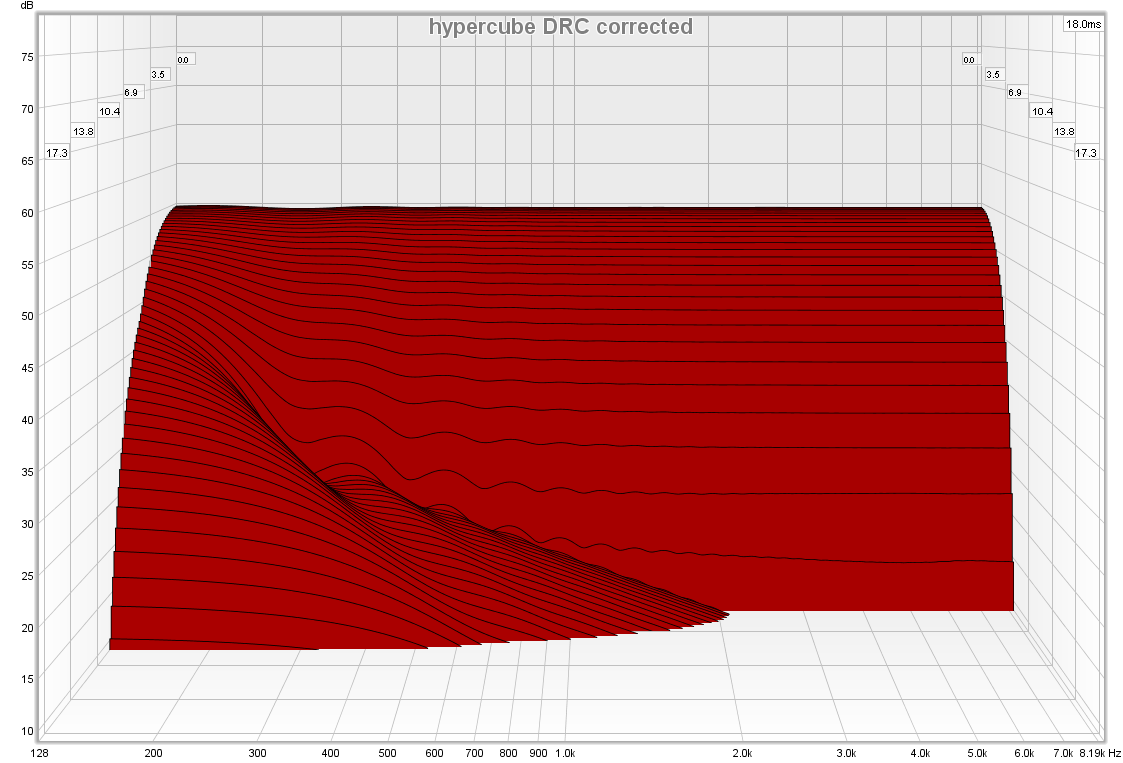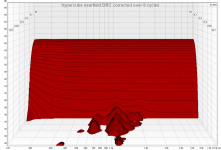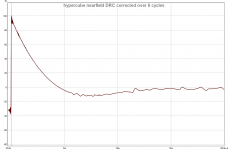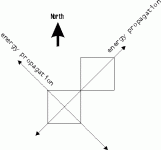What are your waterfall plot settings? Window, Max time , steps , smoothing, etc. ?
oops, don't miss post 460 on the previous, I think we posted at the same. I think the window and rise time were both about 8ms.
ok X, same 1/3 octave smoothing but now with DRC correction and 6 octave range.
Now, where's that mug? 😉
How do you get it that clean all the way down? Are you living in a desolated area? 🙂

Agree Greg takes DRC to upper limit and think it get close to become art.
Sound clips did sound incredible too cheers and thanks sharing.

Sound clips did sound incredible too cheers and thanks sharing.

I wouldn't like the reflection off of those ruins...
The speaker was 42" from reflective surfaces with mic 3" from phase plug. Combined with DRC and lots of smoothing....it does look impossible huh?
The speaker was 42" from reflective surfaces with mic 3" from phase plug. Combined with DRC and lots of smoothing....it does look impossible huh?
I would run into other problems over here... which dust cap to choose 😀...
Looking good though. How loud is it recorded at? Do you know? I always get my Radioshack SPL meter out and calibrate at the mic position, so all my plots are in true dB (or as close as the SPL meter is getting me to it).
Looking good though. How loud is it recorded at? Do you know? I always get my Radioshack SPL meter out and calibrate at the mic position, so all my plots are in true dB (or as close as the SPL meter is getting me to it).
You know, now that I think about it, I should check when I get home that the clip used for that impossibly good waterfall didn't get cropped too short by Audicty like the other....
I've been meaning to ask: I don't have an SPL meter but if I know the sensitivity of my mic as well as the preamp gain can I estimate volume level somehow?
I've been meaning to ask: I don't have an SPL meter but if I know the sensitivity of my mic as well as the preamp gain can I estimate volume level somehow?
Your ears are good for +/- 5dB. Comfortable listening levels for me is 78dB to 82dB, above that it's considered "loud" in my house and I am surprised how close I can guess compared to my calibrated mic.
You should get a calibrated USB mic. Skip the pre-amp and mic cal issue. UMM-6 from Dayton on sale sometimes for $70. Or $20 get the calibrated iPhone mic.
You should get a calibrated USB mic. Skip the pre-amp and mic cal issue. UMM-6 from Dayton on sale sometimes for $70. Or $20 get the calibrated iPhone mic.

This is the stuff of dreams. I don't understand how this is achievable. What does it look like at 1/12 octave?
I assume you have a perfect Step Response too?
Last edited:
Newer nearfield measurement made with REW
As it turns out, I found a newer hypercube nearfield measurement made with REW that seems to reveal some low level ringing not present in the first measurement (made with the sweep recorder provided with DRC) and I applied DRC correction. Seems more realistic, but still quite good I'd say...
edit: I have since applied adhesive vinyl damping sheets to all interior hypercube surfaces, so I expect the next measurement to be at least slightly better...
As it turns out, I found a newer hypercube nearfield measurement made with REW that seems to reveal some low level ringing not present in the first measurement (made with the sweep recorder provided with DRC) and I applied DRC correction. Seems more realistic, but still quite good I'd say...
edit: I have since applied adhesive vinyl damping sheets to all interior hypercube surfaces, so I expect the next measurement to be at least slightly better...
Attachments
Last edited:
Perhaps the noise floor was too high with the older measurements due to using too short of a sweep causing Audacity to remove too much of the "silence"....
Anyway, I think the recently shown sealed/hypercube comparison is valid because the only variable in that case was the enclosure, and the impulse responses were not shortened at all with Audacity.
Anyway, I think the recently shown sealed/hypercube comparison is valid because the only variable in that case was the enclosure, and the impulse responses were not shortened at all with Audacity.
Last edited:
Physical model to support the hypercube idea
Hi all,
I would like to point you towards a model of reality that makes it plausible why the hypercube enclosure might work better than other types of enclosure.
I refer to the books of the late German author L.W. Göring, especially his "Das Geheimnis der Pyramiden-Energie" (The Secret of Pyramid Energy).
See cover here
The basic relevant fact here is explained in the following webpage:
VES-TA Tachyonen
I cannot provide you with a translation, please use Google translator, together with the pictures you will understand the ideas presented.
The basis here is that according to that model of matter reality consists from the micro to the macro of a fractal cuboid structure where the flow of energy between the cubes happens exclusively along the diagonal lines between the top and bottom corners of the adjacent cube cells.
This flow is then along the rims of two inner pyramids within the cube. As the hypercube applied by Matthew is such a structure turned inside out, it makes sense that this kind of enclosure has a better ability to interface with air matter.
In Matthew's blog I found the description of the experience of a speaker "burning-in" to the space where it was located, where visible cone movement was reduced after a while with output staying the same.
This might be explained by the speaker system locking into the surrounding cube matrix where the surrounding matter after a while forms an ideal damping for the speaker, perfect impedance match so to speak. One could further theorize that the "invisibility" of the cone movement was due to a kind of extension of the movement into the surroundings, including the observer, so that the cone itself was relatively stable.
In L.W. Göring's pyramid experiments he found that exact north orientation is important - so GM, could you maybe try if orientation of the speaker makes a difference?
Also, I was wondering, whether maybe the hypercube can be reduced to the shape of one of the inner pyramids, maybe this would also have quite good matching to the surroundings.
Food for thought, cheers,
Achim
Hi all,
I would like to point you towards a model of reality that makes it plausible why the hypercube enclosure might work better than other types of enclosure.
I refer to the books of the late German author L.W. Göring, especially his "Das Geheimnis der Pyramiden-Energie" (The Secret of Pyramid Energy).
See cover here
The basic relevant fact here is explained in the following webpage:
VES-TA Tachyonen
I cannot provide you with a translation, please use Google translator, together with the pictures you will understand the ideas presented.
The basis here is that according to that model of matter reality consists from the micro to the macro of a fractal cuboid structure where the flow of energy between the cubes happens exclusively along the diagonal lines between the top and bottom corners of the adjacent cube cells.
This flow is then along the rims of two inner pyramids within the cube. As the hypercube applied by Matthew is such a structure turned inside out, it makes sense that this kind of enclosure has a better ability to interface with air matter.
In Matthew's blog I found the description of the experience of a speaker "burning-in" to the space where it was located, where visible cone movement was reduced after a while with output staying the same.
This might be explained by the speaker system locking into the surrounding cube matrix where the surrounding matter after a while forms an ideal damping for the speaker, perfect impedance match so to speak. One could further theorize that the "invisibility" of the cone movement was due to a kind of extension of the movement into the surroundings, including the observer, so that the cone itself was relatively stable.
In L.W. Göring's pyramid experiments he found that exact north orientation is important - so GM, could you maybe try if orientation of the speaker makes a difference?
Also, I was wondering, whether maybe the hypercube can be reduced to the shape of one of the inner pyramids, maybe this would also have quite good matching to the surroundings.
Food for thought, cheers,
Achim
Thanks, Achim.
So far I'm having a tough time grasping all of this with the (Google) translation, but I will re-read. I've actually been fascinated with pyramids for a while and have a couple of books about the pyramids of Egypt.
I have a decent compass, and I'd be happy to experiment with directional orientation when I have some time (perhaps someone could suggest a way to test this).
I'm still fascinated by using this shape for a speaker enclosure (or "resonating chamber" if you will) and as a side note, I plan to purchase a high-end saw to start making the pieces myself.
So far I'm having a tough time grasping all of this with the (Google) translation, but I will re-read. I've actually been fascinated with pyramids for a while and have a couple of books about the pyramids of Egypt.
I have a decent compass, and I'd be happy to experiment with directional orientation when I have some time (perhaps someone could suggest a way to test this).
I'm still fascinated by using this shape for a speaker enclosure (or "resonating chamber" if you will) and as a side note, I plan to purchase a high-end saw to start making the pieces myself.
Hello again. Playing catchup here because I've been grinding on a deadline for my latest book. Doing my best to absorb all of the new information. GMAD's waterfalls are the stuff of dreams, indeed. The amount of skill and expertise being brought to bear on Hypercube speakers is humbling, and I'm sure it's best to let your younger and quicker minds explore the limits and ramifications of this geometry. I like the comments about squeaky drum pedals...we used to love hearing the acoustic guitar nonmusic artifacts in From The Beginning by Emerson Lake & Palmer, finger squeaks sliding along guitar strings etc.
"You see it's all clear. You were meant to be here.....from the beginning."
https://www.youtube.com/watch?v=3epPMa5rq0U
"You see it's all clear. You were meant to be here.....from the beginning."
https://www.youtube.com/watch?v=3epPMa5rq0U
Hello again. Playing catchup here because I've been grinding on a deadline for my latest book. Doing my best to absorb all of the new information. GMAD's waterfalls are the stuff of dreams, indeed. The amount of skill and expertise being brought to bear on Hypercube speakers is humbling, and I'm sure it's best to let your younger and quicker minds explore the limits and ramifications of this geometry. I like the comments about squeaky drum pedals...we used to love hearing the acoustic guitar nonmusic artifacts in From The Beginning by Emerson Lake & Palmer, finger squeaks sliding along guitar strings etc.
"You see it's all clear. You were meant to be here.....from the beginning."
https://www.youtube.com/watch?v=3epPMa5rq0U
"You see it's all clear. You were meant to be here.....from the beginning."
https://www.youtube.com/watch?v=3epPMa5rq0U
North orientation
Hi,
I made a sketch showing the directionality of energy propagation according to Göring's book.
As magnetic north is in flux, it's good to use a compass instead of a map. Just make sure there is no metal near as it will deviate the needle.
Make out where the hypercube enclosure most strongly resonates along the "energy transfer lines".
As to sawing: Has anyone tried 3D printing as suggested by Derek? It might be worth trying contact drivers attached to the hypercube structure instead or complementary to speaker drivers in order to excite the energy transfer lines.
Hi,
I made a sketch showing the directionality of energy propagation according to Göring's book.
As magnetic north is in flux, it's good to use a compass instead of a map. Just make sure there is no metal near as it will deviate the needle.
Make out where the hypercube enclosure most strongly resonates along the "energy transfer lines".
As to sawing: Has anyone tried 3D printing as suggested by Derek? It might be worth trying contact drivers attached to the hypercube structure instead or complementary to speaker drivers in order to excite the energy transfer lines.
Attachments
Well, this post is the real highlight of the whole nonsense about the "magical" properties of the hypercube loudspeaker enclosure.I would like to point you towards a model of reality that makes it plausible why the hypercube enclosure might work better than other types of enclosure.
I refer to the books of the late German author L.W. Göring, especially his "Das Geheimnis der Pyramiden-Energie" (The Secret of Pyramid Energy).
See cover here
An STL file for a hypercube speaker
In case anyone wants to peruse one to 3D-print a speaker (or otherwise manufacture it), you're welcome to use this STL file as a starting point. (I have it in other formats too, if so desired).
I'm currently exploring the possibility to use this file to create a case using 3D-printing.
The dimensions in this file are suited for a speaker cone with 10cm radius. In this particular case it was custom calculated for the FaitalPRO 4FE32 - 4" 30W 8Ohm Neodym speaker cones.
Note that the file has a .txt extension due to the braindead attachment-policy of the site; rename it to .stl before use.
In case anyone wants to peruse one to 3D-print a speaker (or otherwise manufacture it), you're welcome to use this STL file as a starting point. (I have it in other formats too, if so desired).
I'm currently exploring the possibility to use this file to create a case using 3D-printing.
The dimensions in this file are suited for a speaker cone with 10cm radius. In this particular case it was custom calculated for the FaitalPRO 4FE32 - 4" 30W 8Ohm Neodym speaker cones.
Note that the file has a .txt extension due to the braindead attachment-policy of the site; rename it to .stl before use.
Attachments
What are the max dimensions of your model so we know if it will fit on our printer beds? One way to keep part size down is to make two halves inter-locking petals of a flower like.
Thanks.
Thanks.
- Status
- Not open for further replies.
- Home
- Loudspeakers
- Full Range
- Hypercube Loudspeakers


